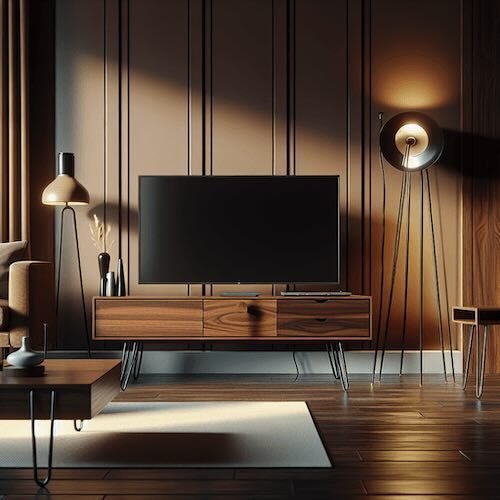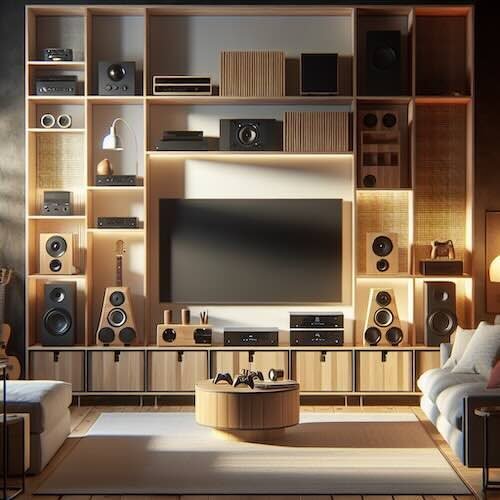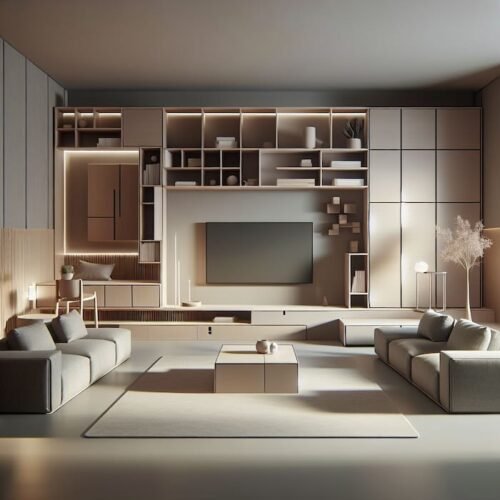
In recent years, mid-century modern design has enjoyed a remarkable comeback, capturing the hearts of both home decor enthusiasts and interior designers. A tribute to design innovation of the mid-20th century, this style is characterized by sleek lines, functional forms, and organic influences. Among the treasures of this era is mid century entertainment center and TV stand. These centers offer unique features catering to different aesthetic and functional requirements.
Here, we’ll analyze the structural differences and functional advantages of a mid-century modern entertainment center versus a TV stand and how they can transform living spaces. No matter what type of apartment or home you’re furnishing, understanding these differences will help you make the right choice. This is based on your personal style and space needs.
Identifying a TV Stand from a Mid Century Entertainment Center
Despite both housing televisions, their design elements meet different needs. Typically, mid-century modern TV stands prioritize open space and simplicity, which makes them ideal for smaller rooms. Mid-century modern entertainment centers, on the other hand, offer both functionality and aesthetic appeal with built-in cabinetry and fireplaces in order to provide additional storage without sacrificing style.
These distinctions will help you select the perfect piece for your living room, ensuring it does more than meet your needs – it complements the overall design theme of your home.
1. Differences in Design and Aesthetics

TV stands from the mid-century modern era are characterized by their streamlined shapes and minimalist designs. With their low height, these stands keep the television at the center of the room without dominating it. Tapered legs and subtle embellishments add charm to their simplicity while maintaining their charm.
Contrary to this, a mid-century modern entertainment center offers a much more comprehensive structure. The pieces are designed with shelves, drawers, and cabinets so that they can be used as storage and display units. Often serving as a statement piece with its bold, timeless design, entertainment centers command attention.
There is something magical about a mid-century modern TV stand because it effortlessly blends with any decor. In contrast to colorful or patterned walls, a mid-century modern TV stand in white brightens a room. The choice between these two styles ultimately comes down to whether you prefer minimalism or multifunctionality.
2. Functionality and Storage Capacities

Choosing a mid-century modern entertainment center or TV stand should be based on functionality. A mid-century modern TV stand serves its primary purpose by holding the television, offering a simple and elegant solution with minimal storage. These stands are ideal for those who prefer a clutter-free environment and prioritize open space.
In contrast, a mid-century modern entertainment center offers extensive storage. These centers often feature a variety of compartments, suitable for housing electronic devices, media collections, and decorative items. A mid-century modern entertainment center with a fireplace adds an extra element of coziness and ambiance, combining practicality with luxury.
Whether you are a family or an avid collector, an entertainment center offers a wealth of extra storage. When choosing storage pieces, consider your needs and how each piece will contribute to your lifestyle.
3. Sizing and Space Considerations

Size and space considerations determine the right mid century modern furniture for your home. The mid-century modern TV stand typically requires less space, making it a good choice for small rooms or apartments. Compact design allows it to fit comfortably in tight spaces without sacrificing style.
Due to its comprehensive structure, a mid century entertainment center requires more space. In a spacious living area, an entertainment center can enhance the overall aesthetic of the room. Measure your room carefully to avoid having the piece overwhelm the space.
The type of furniture you choose should complement the scale of your living room and the arrangement of other pieces in your room.
4. Real Wood vs. Composite Materials

When selecting furniture, there is a big difference between real wood and composite materials. Real wood adds authenticity and durability to mid-century modern pieces. Real wood TV stands offer a warm, natural look that ages gracefully, developing a unique patina over time.
In some cases, composite materials, such as MDF or particleboard, can mimic the appearance of wood while costing less. Despite their short lifespan, they offer durability and versatility. It’s up to you to decide which material is best for you based on your budget, preference for authenticity, and long-term goals. Real wood is a timeless investment, while composite materials offer versatility and affordability.
5. Compatibility with Modern Technology

In today’s tech-driven world, furniture pieces must be compatible with modern technology. Mid century television consoles offer straightforward solutions for housing televisions, with open shelves or discreet cable management. Their focus is on simplicity and ease of use.
As compared to entertainment centers, mid century entertainment centers provide more functionality. Their compartments and cable management options allow them to accommodate gaming consoles, sound systems, and streaming devices. The adaptability of these units makes them ideal for tech-savvy individuals who enjoy integrating technology seamlessly into their homes.
Determine which pieces of tech are best for your gadgets and how they can enhance your entertainment experience.
6. Flexibility and Adaptability

Oftentimes, Mid Century Modern entertainment centers offer a wide variety of configurations and adaptability options. The modular components of many models can be rearranged or expanded, accommodating evolving needs and seamlessly adjusting to technological advances and lifestyle changes. Any living space would benefit from their versatility.
A TV stand, on the other hand, is less structurally flexible, but due to its compact size and lightweight, it is easier to move and reposition. They are ideal for renters or those who frequently change their living arrangements. Their simplicity allows them to adapt to a variety of environments.
A mid-century entertainment center and TV stand combine timeless appeal with unique advantages. Knowing their differences in size, storage, design, materials, and flexibility will help you make an informed decision.
Pros and Cons of TV Stands
Every furniture choice involves trade-offs, and selecting between a TV stand and an entertainment center is no different. On the plus side, a mid-century modern TV stand offers a light, airy feel, perfect for spaces where openness is key. In addition to providing a warm and welcoming atmosphere in your home, quality furniture lasts a long time.
- Versatile addition to any room.
- Compact design fits smaller spaces, maximizing floor space.
- Minimalist design blends with various decor styles.
- Easy to rearrange or relocate, offering flexibility.
- Suitable for living rooms, bedrooms, or offices.
- Sleek design may not suit those needing extensive storage.
- Fewer shelves and compartments for media equipment and decor.
- Limited space for displaying books, photographs, or collectibles.
- Ideal for those prioritizing minimalism and a clean look over storage.
Pros and Cons of Mid Century Modern Entertainment Center
An entertainment center might be more advantageous if storage is a primary concern. You can keep your living area neat and tidy by tucking away electronics and accessories in its compartments and shelves. What’s the downside? With its size and presence, it can dominate a room.
- Making the Final DecisionPlenty of shelves, cabinets, and drawers for storage.
- Accommodates media equipment such as speakers, game consoles, etc.
- Ideal for displaying books, photos, decorative items.
- Provides a focal point in the room with its larger size.
- Takes up more floor space than a TV stand.
- May not fit well in smaller rooms or apartments.
- Can be challenging to move or rearrange due to its size.
Choosing Between a TV Stand and a Mid Century Entertainment Center
The decision to invest in a TV stand or an entertainment center hinges on several factors that influence the overall aesthetic and functionality of your living area.
Small spaces like apartments or cozy living rooms are ideal for TV stands.The entertainment center is spacious, ideally suited for large areas. It serves as the focal point of the room.
In comparison, TV stands offer minimal storage and are sleek and less bulky, while entertainment centers provide ample storage for media devices, books, and decorations.
These TV stands feature clean lines, vintage charm, and a wide range of styles. Having an entertainment center that is ornate and grand may not work with a minimalist or modern decor.
TV stands are easily moved, making them ideal for frequent furniture rearranging or renting.Despite being modular, entertainment centers are not very mobile due to their size and weight.
In terms of affordability, economy, and style, TV stands are more affordable and economical. It is a costly investment, but entertainment centers provide more storage space and are visually appealing.
Unifying the Elements
When choosing a mid-century modern TV stand or entertainment center, keep aesthetics, functionality, and personal preferences in mind. You can elevate your living space with each option’s unique features. Understanding the differences and assessing your own needs can help you find the best option for your home.
No matter what you choose, the timeless appeal of mid-century modern design will ensure that you will enjoy your purchase for many years to come. Design a living space that reflects your personality and love for classic design.
